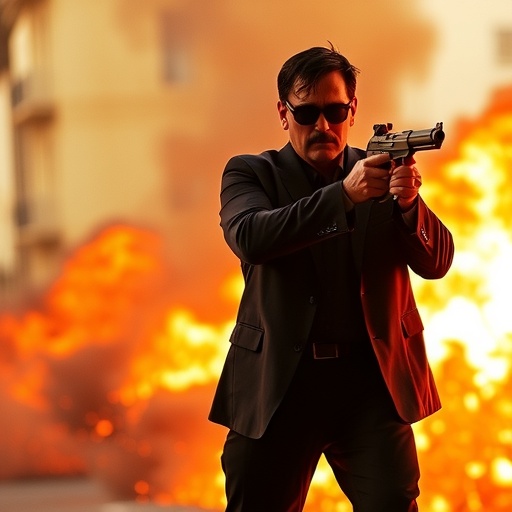Michael Mann’s Heat 2 Secures $37.2 Million California Tax Incentive, Boosting Los Angeles Film Production
In a major win for Hollywood’s revival, director Michael Mann’s long-awaited sequel Heat 2 has clinched a staggering $37.2 million tax credit from California’s Film and Television Tax Credit Program. This incentive, part of the state’s expanded efforts to lure big-budget productions back home, ensures that the high-stakes crime thriller will film extensively in Los Angeles, breathing new life into the city’s storied film industry three decades after the original Heat captivated audiences worldwide.
- From Novel to Screen: The Turbulent Path to Heat 2 Production
- Unlocking the $37.2 Million Boost: How California’s Tax Program Fuels Heat 2
- Los Angeles Prepares for Heat 2’s High-Octane Filming Onslaught
- United Artists Steps Up: Casting Rumors and Creative Vision for Heat 2
- Heat 2’s Arrival Signals Hollywood’s Rebound and LA’s Enduring Appeal
The announcement, made by the California Film Commission on Thursday, underscores a pivotal moment for Heat 2, which has navigated years of development hurdles before landing at United Artists. With principal photography slated to begin in early 2025, the project promises to deliver pulse-pounding action sequences across iconic LA locations, from the neon-lit streets of downtown to the sprawling freeways that defined the 1995 classic. This California tax incentive not only offsets production costs but also highlights the state’s commitment to retaining jobs and fostering economic growth in an industry battered by streaming wars and runaway productions.
Michael Mann, the visionary behind films like Collateral and The Insider, has long dreamed of expanding the Heat universe. The original film’s legendary bank heist scene and the electrifying face-off between Al Pacino’s volatile cop and Robert De Niro’s stoic criminal mastermind have cemented its status as a genre-defining masterpiece. Now, with Heat 2, Mann aims to bridge past and future, drawing from the 2022 bestselling novel he co-authored with Meg Gardiner—a book that sold over 500,000 copies in its first year and topped charts on The New York Times bestseller list.
From Novel to Screen: The Turbulent Path to Heat 2 Production
The road to Heat 2 has been as gripping as any Mann-directed chase scene. Development on the sequel began shortly after Heat‘s release in 1995, but it stalled amid script rewrites, casting uncertainties, and shifting studio priorities. Warner Bros., the original film’s distributor, held rights for years, but creative differences and Mann’s packed schedule—marked by projects like the 2015 Blackhat—pushed the project into limbo.
Everything changed in 2022 with the release of the Heat 2 novel, a dual-timeline narrative that serves as both prequel and sequel. Spanning from 1988 to 2000, the book delves deeper into the backstories of characters like Neil McCauley (De Niro) and Vincent Hanna (Pacino), while introducing new threats in a post-Heat world. Critics praised its meticulous detail and Mann’s signature blend of procedural realism and emotional depth. “The novel was a way to keep the fire alive,” Mann told Variety in a 2022 interview. “It allowed us to explore the ‘what ifs’ without the constraints of immediate production.”
The book’s success reignited interest, leading to a rights shuffle that landed Heat 2 at United Artists, the MGM-owned banner known for bold, auteur-driven fare like No Time to Die. United Artists’ involvement signals a greenlight for Mann’s ambitious vision, with a reported budget exceeding $150 million. Production insiders reveal that pre-production is already underway, with location scouts mapping out shoots in Boyle Heights, the Los Angeles River, and even recreating the iconic Bradbury Building interiors.
This journey mirrors broader Hollywood trends. Sequels to ’90s classics—think Top Gun: Maverick or Twisters—have proven box-office gold, grossing billions amid nostalgia-driven audiences. For Heat 2, the stakes are personal: Mann, now 81, has described this as a passion project that could cap his illustrious career. The California tax incentive removes a key financial barrier, allowing Mann to focus on artistry rather than austerity.
Unlocking the $37.2 Million Boost: How California’s Tax Program Fuels Heat 2
California’s Film and Television Tax Credit Program, relaunched in 2020 with a $330 million annual allocation, has become a lifeline for productions fleeing to tax-friendly locales like Georgia and New Mexico. The program offers rebates of up to 25% on qualified spending, with an additional 5% “uplift” for projects hiring local crews and filming in underutilized zones. Heat 2‘s $37.2 million award—the largest single allocation in the current round—reflects its projected $200 million-plus spend in the state, qualifying it for the maximum uplift.
California Film Commission Executive Director Audrey L. Phillips hailed the approval in a statement: “Heat 2 exemplifies the high-caliber projects our expanded program attracts. By investing in Los Angeles production, we’re not just supporting one film; we’re revitalizing an ecosystem that employs thousands.” The incentive covers expenditures like crew wages, equipment rentals, and post-production, with strict rules mandating at least 75% of spending occur in California.
Statistically, the program has been a game-changer. Since its inception in 2009, it has approved over $3.3 billion in credits, generating $26 billion in economic activity and creating 197,000 jobs. For Heat 2, this translates to an estimated 2,500 direct jobs, from grips and gaffers to stunt coordinators and visual effects artists. The Los Angeles production arm will particularly benefit, as the film commits to shooting 90% of its scenes locally—a boon for a city that lost 20% of its film workforce to out-of-state migrations between 2018 and 2022, per the California Film Commission.
Mann’s history with California incentives adds context. He previously utilized credits for Public Enemies (2009), which filmed partially in LA despite a Midwest setting. Now, with Heat 2, the program enables authentic location work that streaming-era budgets often sideline. “These incentives are the difference between shooting in a soundstage in Atlanta or capturing the raw energy of LA at dawn,” said producer Art Linson, who collaborated with Mann on the original Heat.
- Key Program Stats: $330M annual budget, 25-30% rebate rate, focus on diverse hires (at least 50% from underrepresented groups).
- Heat 2 Specifics: $37.2M credit on $148.8M qualified spend, prioritizing LA-based vendors.
- Broader Impact: Expected to inject $500M into local economy via multiplier effects (hotels, catering, transportation).
Los Angeles Prepares for Heat 2’s High-Octane Filming Onslaught
Los Angeles, the beating heart of American cinema, is gearing up for Heat 2‘s arrival like a city awaiting a blockbuster storm. The Los Angeles production will span six months, transforming neighborhoods into extensions of Mann’s gritty underworld. Early plans include recreating the infamous downtown shootout with practical effects—explosions, car chases, and helicopter pursuits—drawing on the city’s unparalleled infrastructure.
LA’s film community is buzzing. The Hollywood Reporter notes that local unions like IATSE and Teamsters have already begun staffing calls, anticipating a surge in overtime hours. “Michael Mann films are events,” said LA City Councilmember Nithya Raman, whose district includes key filming zones. “Heat 2 will spotlight our diverse communities while providing real economic relief.” The production is committed to community outreach, including hiring from LA’s BIPOC and veteran populations, aligning with California’s equity mandates.
Historically, Heat was a love letter to LA, shot almost entirely on location to capture its nocturnal pulse. Mann’s cinematographer, Dante Spinotti, who returns for the sequel, emphasizes authenticity: “We want that same verisimilitude—the way light hits the 101 Freeway or shadows play in Echo Park.” Challenges abound, from traffic disruptions to SAG-AFTRA contract nuances post-2023 strike, but the California tax incentive provides a buffer.
Environmental considerations are also front and center. With climate pledges in vogue, Heat 2 will use electric vehicles for chases and LED lighting to minimize carbon footprint, earning bonus points under the program’s green initiatives. Local businesses, from craft services in Van Nuys to prop houses in Burbank, stand to gain. A 2023 study by the LAEDC estimates that every $1 in film spending generates $7.50 in local output—news that has merchants along Sunset Boulevard preparing for the influx.
Yet, not all is seamless. Critics of the tax program argue it subsidizes profitable studios at taxpayer expense, with returns skewed toward high-end projects. Still, for Heat 2, the math adds up: United Artists projects a global box office north of $800 million, based on the original’s $187 million haul (adjusted for inflation).
United Artists Steps Up: Casting Rumors and Creative Vision for Heat 2
Under United Artists’ stewardship, Heat 2 is evolving from script to spectacle. The studio, revitalized post-MGM’s Amazon acquisition, sees the film as a tentpole to reclaim its legacy of hits like the Bond series. Executive producer David Manpearl confirmed to Deadline: “We’re giving Michael Mann full creative control. This isn’t a cash-grab sequel; it’s an expansion of a universe fans have demanded for 30 years.”
Casting remains a hot topic. While Pacino and De Niro’s involvement is unconfirmed—both in their 80s—the novel’s timeline opens doors for younger actors portraying flashbacks. Names like Austin Butler (for a pre-Heat McCauley) and Zendaya (as a new femme fatale) circulate in trade reports, though Mann has stayed mum. The director’s track record with A-listers—Tom Cruise in Collateral, Daniel Craig in Heat‘s digital re-release—suggests star power aplenty.
Mann’s vision blends old and new: state-of-the-art VFX for heists, married to practical stunts that defined the original. The score, potentially reuniting Hans Zimmer (who contributed to Heat‘s expanded cuts), promises orchestral intensity. United Artists is eyeing a summer 2026 release, positioning Heat 2 against superhero fatigue with raw, character-driven drama.
Behind the scenes, the Los Angeles production will leverage cutting-edge tech like AI-assisted storyboarding, while honoring Mann’s analog roots. Script revisions incorporate novel elements, such as McCauley’s South American exploits and Hanna’s family struggles, ensuring emotional layers beneath the action.
- Development Milestones: 1995: Original Heat release; 2015: Sequel talks heat up; 2022: Novel drops; 2024: UA acquisition and tax credit win.
- Creative Team: Mann directing, Gardiner consulting, Spinotti on camera— a reunion of Heat alumni.
- Challenges Ahead: Balancing legacy with innovation, navigating post-strike labor costs.
Heat 2’s Arrival Signals Hollywood’s Rebound and LA’s Enduring Appeal
As Heat 2 revs up, its ripple effects extend far beyond the set. The California tax incentive positions Los Angeles as a production powerhouse once more, countering the exodus to Vancouver and Atlanta. Economists project 10,000 ancillary jobs from vendor contracts alone, bolstering a sector that contributes $15 billion annually to the state’s GDP.
For Michael Mann, this is vindication. At a recent AFI panel, he reflected: “Heat was about lives intersecting in the city’s chaos. Heat 2 will show how that chaos endures.” United Artists anticipates marketing tie-ins, from novel reprints to AR experiences tracing Heat locations.
Looking ahead, Heat 2 could inspire a wave of location-based blockbusters. With streaming giants like Netflix scouting LA for originals, the tax program’s success might prompt further expansion—perhaps to $500 million annually. For fans, it’s a chance to relive ’95 magic; for the industry, a blueprint for sustainable growth. As cameras roll on Los Angeles production, one thing’s certain: the heat is back, and it’s scorching.









